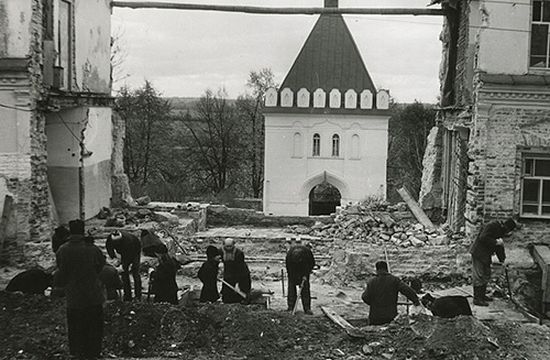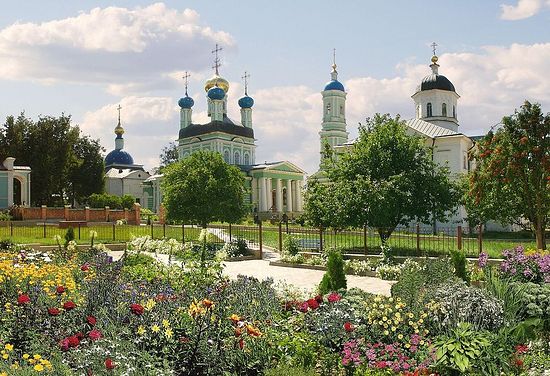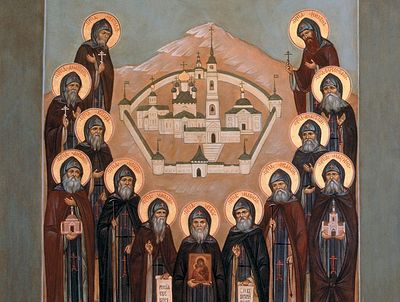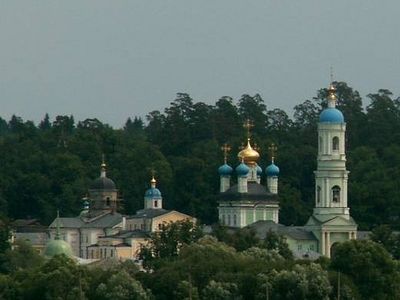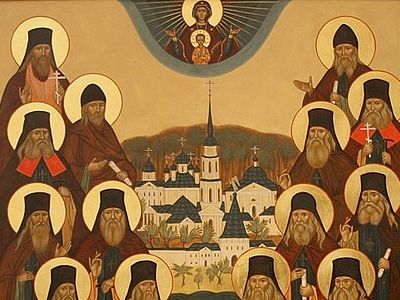In 1988, Optina Monastery was given back to the Russian Orthodox Church and reopened after 65 years of desolation. The communist regime had closed it in 1923, and during Perestroika, still in the USSR, monastic life was revived. Much has happened since 1990 when an American recently converted to Orthodoxy made a pilgrimage to the famous home of the Optina Elders—all of the original churches have been rebuilt, new ones added, and the brotherhood is flourishing. Nevertheless, we can wistfully remember those blessed days when Russian Orthodox Christians were sacrificing their time and talent to rebuilt Optina. Here are the impressions of that pilgrim, published in the Orthodox Word (No. 152).
The scenery along the road from Moscow to Kozelsk , the town where Optina Monastery is located, seems to become more green, more beautiful, more revealing of the gentle, sweetly endearing Russian countryside the closer one comes to the Monastery. My travelling companions and I pulled off to the side of the road to have lunch upon the spring grass amongst the birch and pine. Taking out our simple meal, and sighing over the loveliness of the weather, the forest, the cake, and the fact that we were on our way to Optina, we began to notice the mosquitos, which, lunching upon us, somewhat marred the overall picture, reminding us that complete and total happiness is not to be found on the earth.
The forest and meadows appear largely undisturbed, and some of the small villages look as they must have seventy years ago. The view of the city of Kaluga, very near Kozelsk on the banks of the Oka River, looks very much like a pre-revolutionary engraving I have seen of that city, only perhaps slightly more decrepit with age. But the skyline that greeted us when we reached Kozelsk , as across a wide field the domes of Optina rose into view, proved that the communists destroyed a great deal more than they built. Missing is the great bell tower, once over three stories tall; and of the many pre-revolutionary domes, only a few now glisten. Nevertheless, the Monastery stands majestically afar off; and as we approached, a reverent hush fell involuntarily upon the car, as we mentally prepared ourselves for a visit to this holy place .
When we drove up to the monastery gate, we saw the hired laborers scuttling and dragging around, tractors, piles of bricks and wood, hammers banging. In spite of the activity, there was an uncanny silence, and a sense that this was indeed a monastery, not just a work site. I doubt that all or even the majority of the construction workers are “believers,” as the Russians call those people who are practicing, pious Orthodox Christians; but there are some people who are now volunteering their time to work on the reconstruction of monasteries, and probably these people were mixed in with the group. Men come to build while women work in the kitchen; and many specialists in restoration, iconography, etc., offer their services as well. There are many people who are very anxious to have the monasteries returned to God, and are ready to do whatever it takes.
Truly it is an expression of the same love of God and piety that built these monuments of Christian culture in the first place. Looking around at the wreckage, I could imagine that, if one allowed oneself to enumerate all the materials, the labor, the time needed to rebuild what was quickly and viciously ruined by people who must have been much like these workers, one could easily become despondent. But surely it is best not to think of it, and simply get to work. As we walked along the dirt path past the piles of bricks and lumber, we spotted what needed to be our first stop. At the site of what used to be a large graveyard were the comparatively rough graves of four Elders of Optina: Leonid, Macarius, Barsanuphius and Anatole, marked by wooden crosses with covered lampadas attached. Some flowers were strewn over the earthen mounds. This entire graveyard had been ploughed and leveled by the communist “church demolition teams”; so it required the painstaking labors of faithful archeologists to excavate the site, find what they determined to be the bones of these Elders, and reconstruct their graves. After this the monks built a small fenced enclosure for Elders Leonid and Macarius, placing Barsanuphius and Anatole in a common grave at the side of the church. We approached slowly to venerate the Elders, lingering there a bit as the wind blew solemnly around the adjoining church.
When we entered the main church in the Monastery, the monks were reading the prayer of thanksgiving after Liturgy, which gave us enough time to venerate the tombs of Elders Ambrose and Nectarius before the church was closed. In honor of his canonization, Elder Ambrose's relics had been moved from the graveyard to a crypt inside the church and placed near the left altar. It is a beautiful tomb, surrounded by icons and lampadas like glowing roses. The coffin is covered with a small glass sliding window, beneath which lies Elder Ambrose, covered by a black schema-shroud. During vigil, the glass window is pulled back to allow monks and pilgrims to venerate the relics by kissing the Elder's forehead upon the shroud. We left Elder Ambrose, the only Optina Elder glorified by the Moscow Patriarchate,1 feeling blessed and joyful.
Not far from him, in a small, humble room at the rear of the church across from the left altar, was the coffin wherein Elder Nectarius lay, a lampada flickering on the wall above his head. Until less than a year ago, Elder Nectarius had been buried in his town of exile,2 where he reposed, not far from Optina. When Father Evlogy, the current Abbot of the Monastery, was visiting the Elder’s grave, the thought occurred to him to endeavor to have him moved back to Optina. When the move was finally approved, he sent some monks to process with the relics back to the Monastery. As the Abbot waited for the procession at the Elder's former Monastery, a woman arrived bearing a gift. She and all her family were spiritual children of Elder Nectarius, and they had taken extensive notes of his sayings and life. Not knowing that the Eider's relics were being returned, she had travelled to Optina to present these notes to the Abbot. He received them happily, telling her that the Elder would soon be arriving, and that she was welcome to stay to greet the procession. One can imagine the joy with which she heard about the return of her Elder to his rightful home. He was placed in that little room with an icon of the Mother of God, where we venerated him, I with the knowledge that in the West, and especially for us in San Francisco, where our little church is dedicated to him, he is also glorified as a saint, and remains our link to the Optina heritage through his banished spiritual chil dren. As the machinery clanged outside the walls, we stood for a while in silence.

The church has two iconostases: one from an old church, donated by local believers, the other painted for the Monastery. As if affirming the miracle of Optina, and in rejoicing over its return to monasticism, two icons have produced myrrh: one of the Mother of God, and one of the Savior, the latter being one of the recently painted icons on the left iconostasis. Father Evlogy related to us how, one morning before Liturgy, he walked into the church and one of the monks told him that the icon was bearing a fragrant substance. Not wishing to examine the icon too closely as his eyesight is weak, he asked the monk to anoint him with the substance, which was indeed quite fragrant. Truly there must be rejoicing in Heaven over the rededication of Optina; and only through the help of the heavenly powers could it truly take place, for a sorrowful sight it is, this poor, desecrated Monastery.
Besides the bell tower, entire buildings were torn down for no practical reason, a beautiful church leveled, crosses ripped from the domes of others, the interiors so defaced that it is difficult to guess where the altars must have been. Years of work in frescos were literally scraped oft the walls, never to be replaced. The church of St. Mary of Egypt, a masterpiece of a most unusual style of architecture, resembles on the inside a depressed tenement, as though a hellish tornado had whirled through it. There is scaffolding everywhere in the Monastery, and the monks have very little space in which to live. As we explored, we happened upon the living quarters of the hired laborers, which were on the top floor of one of the old churches. It was a large dormitory room, where at least a hundred cots had been set up side by side, clothing draped across and muddy boots kicking out from under them. Laundry, washed in its own way, hung from wherever it could be hung. These same workers were fed by the Monastery in a refectory set aside for them in the building that housed the monastery trapeza.
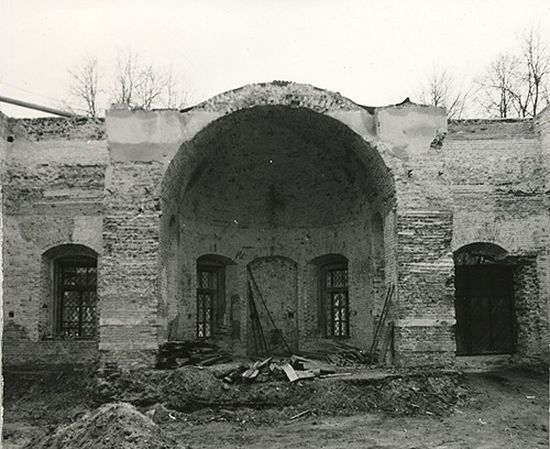
Although conditions seem substandard, these workers are actually privileged by Soviet standards, situated as they are in a monastery where they are fed, and probably treated more humanely. And the materials they worked with were most definitely above average. There is a marked difference between the way things look in monasteries and the way they look in the rest of the Soviet Union, as though there exist two distinct cultures on the one Russian land-Soviet culture, and Orthodox culture; and the monasteries were like tiny Orthodox countries surrounded by the rest of Soviet Russia. Everything in the Monastery is of a higher quality-the food, the craftsmanship, the horticulture, even the bricks themselves. I saw one visitor wistfully admiring the bricks that were piled on the monastery grounds, commenting to a passerby, “Where did such nice bricks come from?” “Those aren't Soviet bricks, those are Orthodox bricks,” came the reply with a wink. Indeed, the difference between what is Soviet and what is Russian is most apparent in the monasteries, for it is clear that the best that Russian culture has produced has always been within the context of its Orthodoxy.
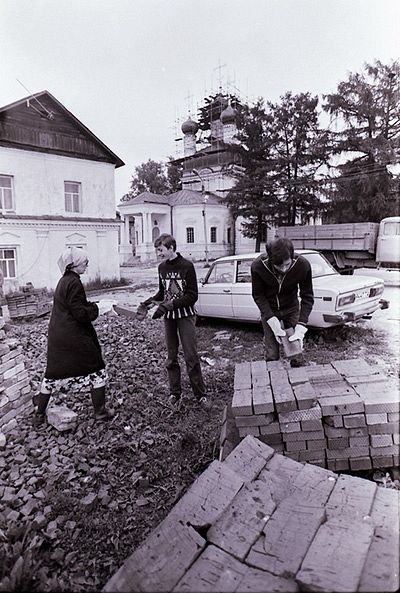
Also living on the monastery grounds, but not associated with it, are families that had been settled in the Skete of St. John the Forerunner prior to the reopening of the Monastery. Once an enclosure into which women were not allowed, the Skete is now subject to any sort of visitor. Tourists are taken through, and pilgrims are allowed to wander, as long as they do not disturb the occupants of the cells, some of whom are monks, but others of whom are simple families with their livestock. Cows and dogs drink from a stagnant pond behind the church. One small church has been reopened, where the brothers lead their 2:00 a.m. prayer rule, which is the only service closed to women. Elder Ambrose's cell is preserved as it was when he lived in it, and shown at times to visitors.
As the day came to a close, and the brothers received the Abbot's blessing after the long vigil, one of the fathers urged us to take a walk along the banks of the Zhizdra River that runs past the Monastery, but to return before the gate was locked. This river is not visible from a distance, so we did not have any idea of the splendor of creation that awaited us on that cool spring evening. Leaving the monastery walls, we followed the path over the bridge which spanned a swampy area, and made our way to the far bank of this gentle river. It seemed to us that even the grass upon the raised bank was more tender than usual; and if it were not for the abundant hungry mosquitos, and the gate closing time, we could have walked along these shores for hours, remarking how unlike other areas of the Soviet countryside it was, for this place was not marked by the various pockets of waste and decay that usually detract from nature in that country. Returning over the bridge, we were greeted by a riotous multitude of bullfrogs, who seemed to be laughing ridiculously. We had never heard anything like it in all our lives.
Fortunately, Optina provides for pilgrims to stay the night, and we turned in at the dormitory room in the refectory building outside the monastery walls-once the monastery infirmary, with a church in one part. There were women there who were staying with the Monastery long-term to work, and some who were just on a brief pilgrimage, as we were. Sitting in the cafeteria outside the dormitory room was the woman who would show us to our beds-a kind woman, as were the others sitting there. All voices were toned down so as not to disturb the sleepers, who were no doubt disturbed enough by the bustle of new arrivals and the snoring of the old. We settled into our humble accommodations, preparing to attend Divine Liturgy, on the morrow’s Sunday morning, after which we would be departing from Optina, perhaps to return someday, perhaps not.
Before we left, we took one last stroll along the path that leads to the Skete, past the stumps of once tall Optina trees, torn away by the winds of godlessness, just as Elder Nectarius and his brothers were exiled from this sacred soil. May we never forget to water with our prayers the springtime soil of Optina, and of all the Russian land, that those trees might grow again.
Catherine Rees
San Francisco, California
August, 1990

